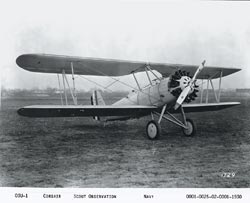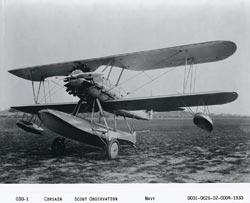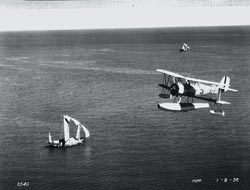|
 The O3U-1, a two-seat scout/bomber, and observation bi-plane, was the first new aircraft produced in Vought’s East Hartford plant.. Both landplane and seaplane models were purchased by the Navy. They were used for every type of flight for which the Navy had letter designations except training.The airplane was usually delivered as a land plane with pontoon and floats provided as spare equipment. The O3U-1, a two-seat scout/bomber, and observation bi-plane, was the first new aircraft produced in Vought’s East Hartford plant.. Both landplane and seaplane models were purchased by the Navy. They were used for every type of flight for which the Navy had letter designations except training.The airplane was usually delivered as a land plane with pontoon and floats provided as spare equipment.
By late 1929 the Navy began to look for a replacement for its aging Corsair I (O2U) fleet. In 1930 Vought submitted a proposal for an O3U-1 aircraft.  By incorporating many of the O2U features with improved engine and equipment performance and improved aerodynamics, the Vought proposal represented a minimum cost approach which impressed the Navy. An initial order for thirty-six O3U-1’s was placed in 1930. When the trials of the aircraft were completed in February 1931 at NAS Anacostia, the O3U-1 had demonstrated the capability to fly 190 mph. The Navy dubbed the O3U-1, “Corsair II”, and placed follow-on orders for 51 more. By incorporating many of the O2U features with improved engine and equipment performance and improved aerodynamics, the Vought proposal represented a minimum cost approach which impressed the Navy. An initial order for thirty-six O3U-1’s was placed in 1930. When the trials of the aircraft were completed in February 1931 at NAS Anacostia, the O3U-1 had demonstrated the capability to fly 190 mph. The Navy dubbed the O3U-1, “Corsair II”, and placed follow-on orders for 51 more.
 The service life and itinerary of a typical Corsair II is exemplified by BuNo 8822 which left the East Hartford plant in January 1931. It was delivered to the heavy cruiser USS Augusta, and from that platform saw the world. It underwent the heat of tropical Panama, the San Diego fogs, Pacific Northwest forest fire smoke, China Seas monsoons, Pacific Ocean typhoons, Hawaiian “Kona” winds, Yangtze River muck and Philippine humidity. By rough estimate, in four years she visited fifty different countries and dipped her wings at sister “Corsairs” in the armed forces of Siam, Cuba and China. She flew on both sides of the international dateline, crossed the equator four times, landed in the Atlantic, Pacific and Indian Oceans, and performed every type of flight for which the Navy had letter designations, except those pertaining to training. The service life and itinerary of a typical Corsair II is exemplified by BuNo 8822 which left the East Hartford plant in January 1931. It was delivered to the heavy cruiser USS Augusta, and from that platform saw the world. It underwent the heat of tropical Panama, the San Diego fogs, Pacific Northwest forest fire smoke, China Seas monsoons, Pacific Ocean typhoons, Hawaiian “Kona” winds, Yangtze River muck and Philippine humidity. By rough estimate, in four years she visited fifty different countries and dipped her wings at sister “Corsairs” in the armed forces of Siam, Cuba and China. She flew on both sides of the international dateline, crossed the equator four times, landed in the Atlantic, Pacific and Indian Oceans, and performed every type of flight for which the Navy had letter designations, except those pertaining to training.
|